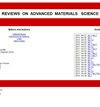Study on dynamic response of cushion layer-reinforced concrete slab under rockfall impact based on smoothed particle hydrodynamics and finite-element method coupling
IF 3.6
4区 材料科学
Q2 MATERIALS SCIENCE, MULTIDISCIPLINARY
引用次数: 0
Abstract
In the rockfall prevention and control project, the reinforced concrete (RC) slab and sand (gravel soil) soil cushion layer are commonly used to form the protection structure, thereby resisting the rockfall impact. Considering that the oversized deformation of the cushion layer under impact load using the finite element simulation cannot converge, this article establishes a numerical calculation model using smoothed particle hydrodynamics–finite-element method coupling (SPH–FEM). First, the standard Lagrange finite-element mesh is established for the whole model using ABAQUS, and then the finite-element mesh of the soil cushion layer is converted to SPH particle at the initial moment of the calculation, and finally the calculation results are solved and outputted. The results indicate that, compared with the results of the outdoor rockfall impact test, the relative errors of the rockfall impact force and the displacement of the RC slab are within 10%, which proves the rationality of the coupling algorithm; moreover, in terms of the numerical simulation, the SPH–FEM coupling algorithm is more practical than the finite element for reproducing the mobility of the rockfall impacting the sand and soil particles. In addition, at an impact speed of less than 12 m·s基于平滑粒子流体力学和有限元法耦合的落石冲击下缓冲层加固混凝土板的动态响应研究
在落石防治工程中,通常采用钢筋混凝土(RC)板和砂(砾石土)土垫层组成防护结构,从而抵御落石冲击。考虑到有限元模拟无法收敛缓冲层在冲击荷载作用下的超大变形,本文建立了平滑粒子流体力学-有限元法耦合(SPH-FEM)数值计算模型。首先利用 ABAQUS 为整个模型建立标准拉格朗日有限元网格,然后在计算初始时刻将土垫层的有限元网格转换为 SPH 粒子网格,最后求解并输出计算结果。结果表明,与室外落石冲击试验结果相比,落石冲击力和 RC 板位移的相对误差均在 10%以内,证明了耦合算法的合理性;而且,在数值模拟方面,SPH-FEM 耦合算法比有限元更能真实再现落石冲击砂土颗粒的流动性。此外,在冲击速度小于 12 m-s-1 时,缓冲层能够吸收 85% 以上的冲击能量,有效保证了 RC 板在小冲击能量下处于弹性工作状态,在大冲击能量下不会发生破坏性损伤;落石的冲击力峰值与速度近似成线性关系,冲击力峰值的模拟值与赫兹理论的理论值基本一致;数值模拟能够很好地再现 RC 板的损伤过程,符合实际情况。SPH-FEM耦合算法在模拟大变形问题上比有限元更加合理,可为落石防护结构的设计计算提供一种新的计算方法。
本文章由计算机程序翻译,如有差异,请以英文原文为准。
求助全文
约1分钟内获得全文
求助全文
来源期刊

Reviews on Advanced Materials Science
工程技术-材料科学:综合
CiteScore
5.10
自引率
11.10%
发文量
43
审稿时长
3.5 months
期刊介绍:
Reviews on Advanced Materials Science is a fully peer-reviewed, open access, electronic journal that publishes significant, original and relevant works in the area of theoretical and experimental studies of advanced materials. The journal provides the readers with free, instant, and permanent access to all content worldwide; and the authors with extensive promotion of published articles, long-time preservation, language-correction services, no space constraints and immediate publication.
Reviews on Advanced Materials Science is listed inter alia by Clarivate Analytics (formerly Thomson Reuters) - Current Contents/Physical, Chemical, and Earth Sciences (CC/PC&ES), JCR and SCIE. Our standard policy requires each paper to be reviewed by at least two Referees and the peer-review process is single-blind.
 求助内容:
求助内容: 应助结果提醒方式:
应助结果提醒方式:


